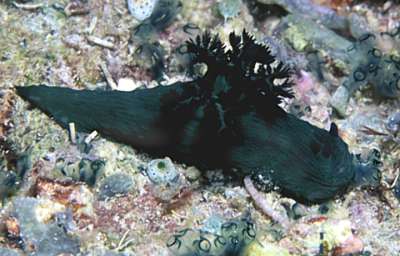
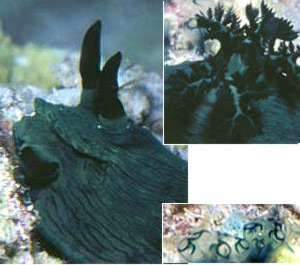
Nembrotha milleri
Gosliner & Behrens, 1997
Order: NUDIBRANCHIA
Suborder: DORIDINA
Superfamily: ANADORIDOIDEA
Family: Polyceridae
Subfamily: Nembrothinae
DISTRIBUTION
Tropical Western Pacific
PHOTO
Florida Group, Solomon Islands, November, 1999. Approx 45 mm long, in 10 meters on reef top. Note clumps of the green-ringed ascidian, Sigillina signifera, on which it feeds, in upper photo, (and in inset). Photo: Mary Jane Adams.
Grey-green to dark green body with blackish longitudinal wrinkles down the body. There are three basal gill stalks which split into five branching gills. The stalks are the green background colour and the gill filaments and lamellae are black as are the rhinophore clubs. Specimens grow to at least 60mm long.
NOTE: There is a 'species' [Nembrotha sp. 14] in East Africa which is probably a form of this species. See Mary Jane Adams' message and Bernard Picton's message. BUT see Bernard Picton's later message in which he thinks the east African 'form' is a distinct species.
Reference:
• Gosliner, T.M. & Behrens, D.W. (1997) Description of four new species of phanerobranch dorids from the Indo-Pacific, with a redescription of Gymnodoris aurita (Gould, 1852). Proceedings of the California Academy of Sciences, 49(9): 287-308.
Rudman, W.B., 2000 (July 30) Nembrotha milleri Gosliner & Behrens, 1997. [In] Sea Slug Forum. Australian Museum, Sydney. Available from http://www.seaslugforum.net/find/nembmill
Related messages
Nembrotha milleri from Verde Island (Philippines).
December 7, 2009
From: Vie Panyarachun
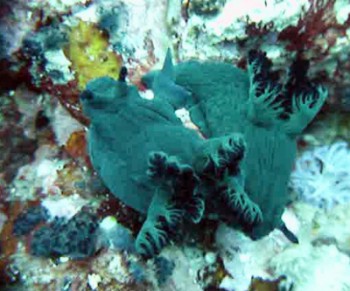
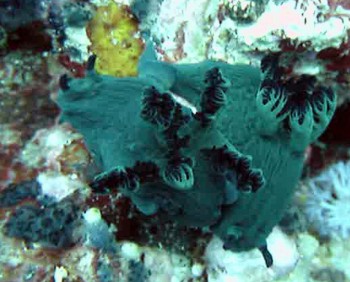
Concerning message #20975:
Dear Dr. Rudman,
I saw these Nembrotha milleri (attempting to mate) back in 2004. Thought you might like a record of this species from the Philippines. Apologies for the poor quality of the images - they were "captured" from a low resolution video.
Locality: "Drop Off," Verde Island, 12 metres, Batangas, The Philippines, Verde Island Passage, 22 June 2004, reef. Photographer: Vie Panyarachun.
Vie
vpanyarachun@hotmail.com
Panyarachun, V., 2009 (Dec 7) Nembrotha milleri from Verde Island (Philippines).. [Message in] Sea Slug Forum. Australian Museum, Sydney. Available from http://www.seaslugforum.net/find/22543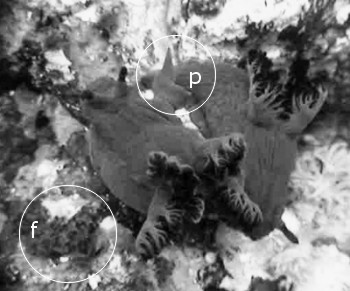
Dear Vie,
Thanks for these photos. In the labelled copy of your photo alongside I have ringed the everted penis [p] and the probable ascidian colony of Sigillina signifera [f - see message #2799] that they were probably eating before they were distracted. The organ I am calling the 'penis' is in fact much more than that as it has a the female genital opening attached much as we can see in Brian Francisco's earlier message #20525 .
Best wishes,
Bill Rudman
Nembrotha from Pemba, Tanzania
April 4, 2008
From: Andrew Sutton
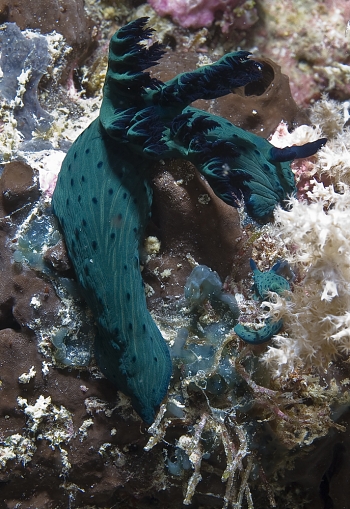
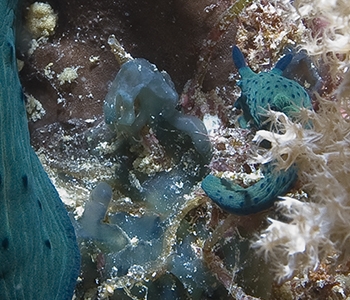
Hello SSF
I was diving off Pemba Island, Tanzania in January 2007. I took the attached photographs of 2 species of Nembrotha. I see that Bernard Picton has one of these [message #6438]. I have attached a shot of this Nembrotha shortly after reproduction (in strong current I should add) - visible on the middle right of the shot,
The 2nd (pinkish red) Nembrotha (though I have a hunch its not), eludes me and this is one i would like to identify...
Locality: Fundu, Pemba, 25 metres, Tanzania, Indian (West), 31 12 2006, clear, oceanic, reef edge and sandy floor. Length: 8inches (aprox). Photographer: Andrew Sutton.
Many thanks for a great site/resource.
Kind regards
Drew Sutton
www.Eco2.com
drew@eco2.com
Sutton.A, 2008 (Apr 4) Nembrotha from Pemba, Tanzania. [Message in] Sea Slug Forum. Australian Museum, Sydney. Available from http://www.seaslugforum.net/find/20975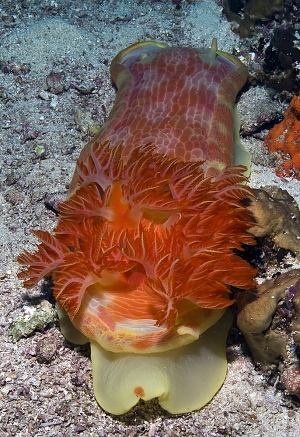
Dear Drew,
The green animal is what I was calling Nembrotha sp 14 on the Forum but have now tentatively identified as Nembrotha milleri. We have a number of records of this East African 'form' on the Forum but until the anatomy is looked at I will still have some doubts about its identity. When you mention 'after reproduction' do you mean that the large animal was mating with the very small one? We sometimes observe mating 'mismatches' like this. These hermaphrodite animals often mature quite early in their development, and often the male system matures some time before the female system. In cases like this it may be that the small animal can store its partner's sperm for some weeks until it female system matures.
The red animal is not a nembrothid. It is Hexabranchus sanguineus, a nudibranch commonly known as the Spanish Dancer because of its swimming display. However when it is crawling like this, its flashy colours are hidden by the folded over edge of the mantle skirt.
Best wishes,
Bill Rudman
Nembrotha milleri in Raja Ampat, Indonesia
March 6, 2007
From: Aaron Fink
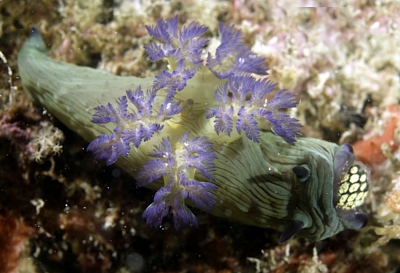
I recently took an extensive trip to the Raja Ampat in Indonesia where I encountered a large number of nudibranchs, several of which I was able to capture photographically, but remain unable to identify.
Locality: Misol Besar Island, 50 ft, Indonesia, Banda, 24 October 2006, Cave along reef. Length: 4 in. Photographer: Aaron Fink.
I am seeking assistance. Many thanks.
Aaron Fink
afink01@comcast.net
Fink, A.S., 2007 (Mar 6) Nembrotha milleri in Raja Ampat, Indonesia. [Message in] Sea Slug Forum. Australian Museum, Sydney. Available from http://www.seaslugforum.net/find/19336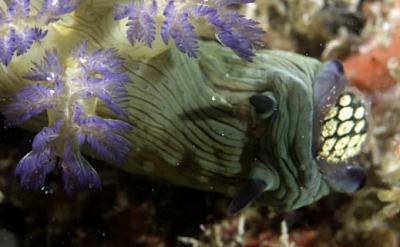
Dear Aaron,
I think this is a pale coloured Nembrotha milleri. The only puzzle is what it has in its mouth. Species of Nembrotha feed on ascidians, so I suspect the white and green object in is mouth is an ascidian or ascidian colony, although I don't recognise it off-hand.
Best wishes,
Bill Rudman
Nembrotha milleri from Sipadan, Malaysia
July 21, 2006
From: Charles Rowe
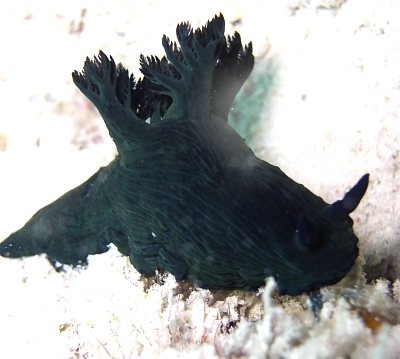
Hi Bill,
This is the third of a series of nudis from my trip to Sipadan which I would like you to identify and comment on. As you can see it is on sand and was taken on a "muck dive" on Mabul
Locality: Sipadan Island, 8-10 metres, Malaysia, 27 April 2006, Sandy bottom. Length: 2 cm.
Charles Rowe
bumff@mweb.co.za
Charles Rowe, 2006 (Jul 21) Nembrotha milleri from Sipadan, Malaysia. [Message in] Sea Slug Forum. Australian Museum, Sydney. Available from http://www.seaslugforum.net/find/16847Dear Charles,
This is Nembrotha milleri.
Best wishes,
Bill Rudman
Nembrotha milleri with orange spots?
May 10, 2006
From: Wilhelm van Zyl
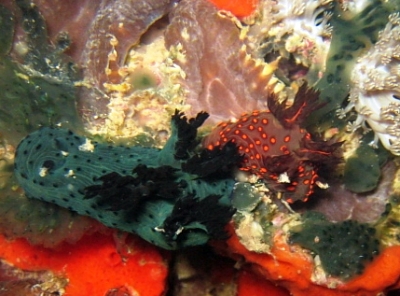
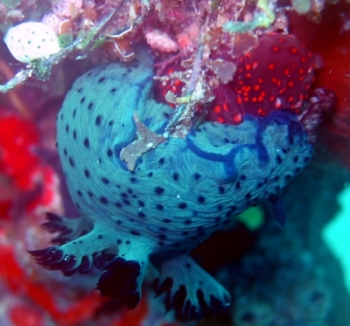
Hi Bill,
I came across these 2 animals, one green with black spots and one dark red with bright red spots. I am pretty sure the green animal is Nembrotha milleri, but the red one is giving me problems. I had 2 theories at the time, They are either mating or the green one is eating the red one. The upper photo was taken by my dive buddy Anelda at Nugwi on Unguja Island. The middle photo I took at Pemba Island. So this was not a chance meeting by two unrelated individuals. The lower photo might also be of Nembrotha milleri, but this one was very dark green, almost purple with red spots. I have also seen a red spotted one on its own but unfortunately could not get a picture.
Locality: Upper: Unguja Island, 16 m. Photo: Anelda Lategan. Middle: Pemba Island, 15 m. Photo: Wilhelm van Zyl. Lower: Pemba Island, 10 m. Photo: Wilhelm van Zyl. Zanzibar, Tanzania. Indian Ocean. Lengths: 8 - 10 cm. 10 October 2005
Regards
Wilhelm
diving@cyberdale.co.za
Van Zyl, F.W., 2006 (May 10) Nembrotha milleri with orange spots?. [Message in] Sea Slug Forum. Australian Museum, Sydney. Available from http://www.seaslugforum.net/find/15283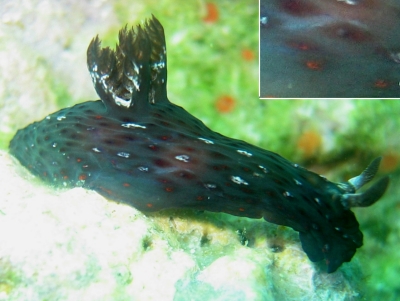
Dear Wilhelm,
This is a very interesting find. The green animal is what I was calling Nembrotha sp. 14 but have tentatively accepted as the western Indian Ocean form of N. milleri, although Bernard Picton remains unconvinced.
As you say, your photos are open to a number of interpretations. Clearly, on two separate occasions black-spotted and red-spotted animals were found together. In your upper photo I assume they are both attracted to the green masses in your photo which we know are the ascidian food of the black-spotted N. milleri [aka Nembrotha sp. 14]. In the middle photo I am sure the black-spotted animal is not eating the red spotted one because it feeds exclusively on ascidians. So they could be mating or they could be feeding close together. The lower photo suggests that both the second two alternatives - mating or feeding together - could be correct because it appears to be a nice intermediate form between the black-spotted animals and the red-spotted ones.
I think what you have discovered is another species which varies in colour from black to red (or orange-red) spots. This would be exciting if it were the first time we had seen this happening in a species of Nembrotha, but I think it is even more exciting that this is at least the third species which does this. The most spectacular example is Nembrotha kubaryana, but we also see it happening in Nembrotha guttata, suggesting a common cause for this phenomenon. Yesterday I briefly discussed [message #16537] a specimen of Risbecia tryoni with orange-red spots instead of the usual blackish purple. I would not be at all surprised if all these black - orange [red, brown] colour swaps had a common cause.
So in answer to your question - I don't think one's eating the other but it's possible they are mating. And thanks for showing us that N. milleri - or its East African lookalike - has a red-spotted colour form.
Best wishes,
Bill Rudman
Is this Nembrotha? climbing into a Tridacna
March 9, 2006
From: Pasquale Pascullo
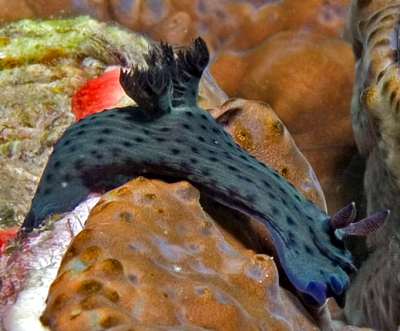
I found this unknown climbing around the shell and then into the clam. I thought that was chancy if the clam closed up. He seemed real smart though, as when he got high on the shell, he stopped, look up and around and when he lent over, he was very cautious. At times, it seemed he didn't want to enter. Looking for food may be?
Locality: Pemba Islands, 7-8 mtrs, Tanzania, East Coast Africa, west Indian Ocean, Feb 08 '06, hard mixed reef rocks/sand. Length: 2 inches. Photographer: Pasquale Pascullo.
Pasquale
pp@ppfotos.com
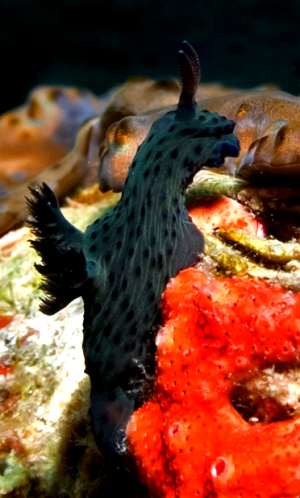
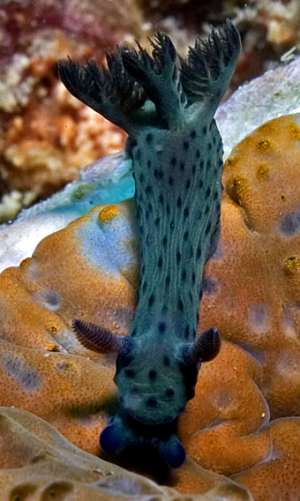
Dear Pasquale,
Probably not a good move for the nudibranch. When observing nudibranch behaviour it is hard not to give them human attributes, but I don't think they are big on risk assessment even if that is what it looked like.
This is a species I first called Nembrotha sp. 14, but later, against the advice of Bernard Picton, decided was most probably a colour form of Nembrotha milleri. Like Bernard, I still have my doubts. Untill someone has to compare the anatomy of the two 'species' we can't be sure.
Best wishes,
Bill Rudman
Nembrotha milleri from East Timor
February 23, 2006
From: Nick Hobgood
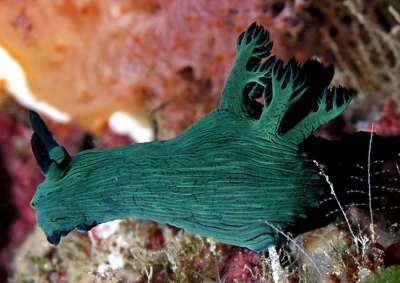
Dear Bill,
Ran into this individual on a wall dive. Originally, I thought it was a N. kubaryana but it does not look quite like the ones in my guides. Can you please help with the ID?
Locality: Black Rock Wall, 12-14 m, East Timor, Banda Sea, 18 February 2006, Coral covered wall. Length: 5-6 cm. Photographer: Nick Hobgood.
Thanks
Nick
nick.hobgood@mac.com
Hobgood, N., 2006 (Feb 23) Nembrotha milleri from East Timor. [Message in] Sea Slug Forum. Australian Museum, Sydney. Available from http://www.seaslugforum.net/find/15902Dear Nick,
This is Nembrotha milleri
Best wishes,
Bill Rudman
Nembrotha milleri with red spots
April 28, 2003
From: Erwin Koehler
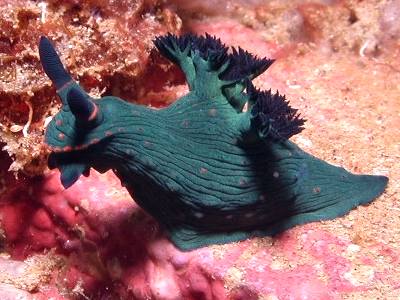
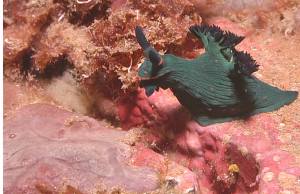
Dear Bill,
Here is another picture of Nembrotha milleri. This one has red spots. It's from the Philippine Islands.
Data:
size 37mm
depth 17m
date 10 March 2003
Negros Oriental Island, Lipayo, divesite "Sarah's Reef"
Cheers Erwin
Erwin@medslugs.de
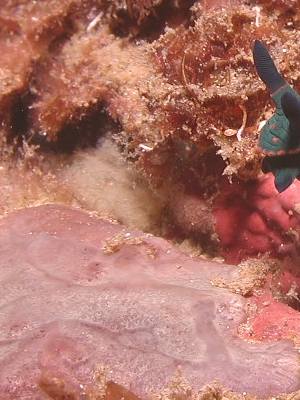
Thanks Erwin,
The pink compound ascidian, in the enlarged part of your photo alongside, makes me wonder if perhaps N. milleri gets some of its colour from its food. This of course is all a bit of a guess because we don't even know if it eats compound ascidians. But as the pink spots seem to be where the excretory glands in the skin are, and as the chemicals in them seem to be associated with their food, it seems worth thinking about,
Best wishes,
Bill Rudman
Nembrotha milleri? from Indonesia
November 28, 2002
From: Jim Bartlett
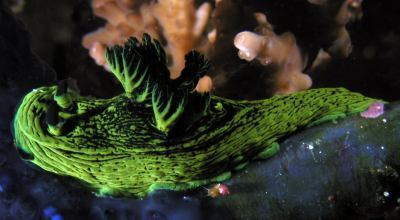
Bill -- What a great forum! A fellow U/W photographer recently turned me on to your site, and it's fantastic!
Attached is a photo of a nudibranch I photographed in Indonesia earlier this month (November 2002). Out of the 20-some species I photographed, this is one of only two I can't ID. It was shot on "W-Reef" off of Padar Island.
Thanks for your help
Jim Bartlett
jim_bartlett@pinnicle.com
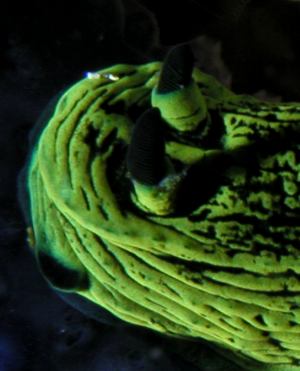
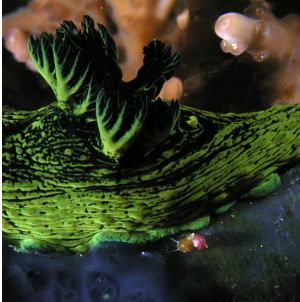
Dear Jim,
This is probably Nembrotha milleri. I haven't seen an animal with quite this black speckling, but I suspect it is a colour form, although of course I could be quite wrong.
Best wishes,
Bill Rudman
Nembrotha milleri from Mauritius
November 15, 2002
From: Marina Poddubetskaia
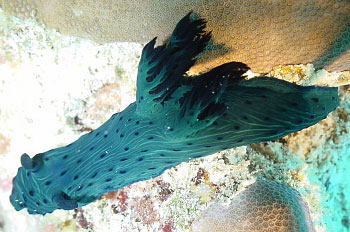
Dear Bill,
Here are some photos of Nembrotha milleri from Mauritius. This species is quite common in the Bay of Pereybere.
The first two photos are of 2 animals I found near each other. One was passive and the second was crawling around.
Upper and Lower Left Photos: Pereybere, Mauritius, Indian Ocean. Site: L’aquarium de Pereybere. Depth: 11m. Size: 10-11cm (Upper) and approx 7cm (Lower Left). October 12, 2002
Lower Right Photo: Gills and anal papilla from an 85-90mm long animal. Pereybere, Mauritius, Indian Ocean. Site: L’aquarium de Pereybere. Depth: 11m. October 15, 2002
Photos: Marina Poddubetskaia - Nembro website
Best wishes,
Marina.
nembro@nembro.info
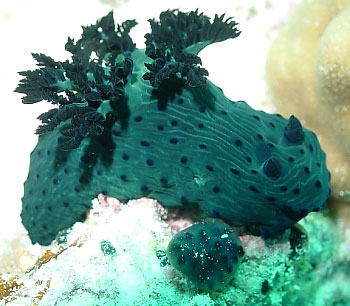
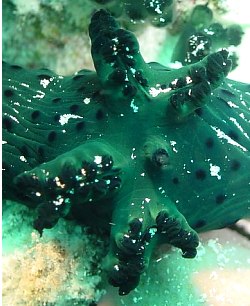
Thanks Marina,
It's nice to get another photo of this east African 'form', 'variety' or species. It is the same as Bernard Picton's photo. I suspect its N. milleri but I suspect we will need to look at its anatomy before we can be sure.
Best wishes,
Bill Rudman
Re: Nembrotha milleri & Nembrotha sp 14
September 7, 2002
From: Bernard Picton
Hi Bill,
I missed this discussion at the time. I'd just like to say that I have seen Nembrotha milleri alive, as well as Nembrotha sp. 14. I don't think they are the same species, these Nembrothas are particularly hard to photograph adequately as the colour seems to come out quite different on film to real life! I certainly considered N. milleri when I was in Tanzania, the body shape and jizz seemed different to me!
Bernard
bernard.picton.um@nics.gov.uk
Picton, B., 2002 (Sep 7) Re: Nembrotha milleri & Nembrotha sp 14. [Message in] Sea Slug Forum. Australian Museum, Sydney. Available from http://www.seaslugforum.net/find/7825Dear Bernard,
As I said in the earlier discussion, I also have my doubts that they are the same. I'll make sure your doubts are clearly noted on the Fact Sheet.
Cheers,
Bill Rudman
Nembrotha milleri from Malaysia
September 7, 2002
From: Richard Houghton
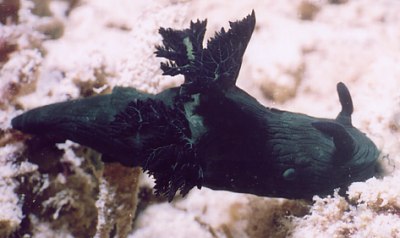
Here is a species of Nembrotha. I collected it with an animal I think is Nembrotha kubaryana. This one is entirely green, the other had telltale red markings. Kapalai Island, Malaysia, August 2002. Coincidentally, both appear to be eating Tunicates - and both photo's were taken on the same dive, around 11am.
Best regards,
Rich
richard_houghton@hotmail.com
Houghton, R., 2002 (Sep 7) Nembrotha milleri from Malaysia. [Message in] Sea Slug Forum. Australian Museum, Sydney. Available from http://www.seaslugforum.net/find/7907Dear Rich,
See my comments on your other message. This is Nembrotha milleri.
Cheers,
Bill Rudman
Nembrotha milleri from Malaysia
July 28, 2002
From: Kenneth
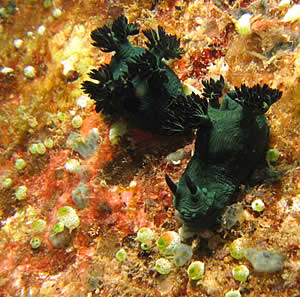
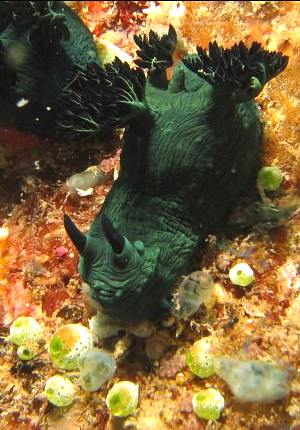
Hi Dr Bill:
On a recent dive trip I spotted this nudibranch. The closest looking nudi I find in my book is Tambja kushimotoensis however these guys don't have stripes of blue on them. So I am wondering if you could help me id. them thanks.
Depth: 8M
Time 2 Pm
Location: Teggol Island, West Malaysia.
Regards
Kenneth
kenneth@pacific.net.sg
Kenneth, 2002 (Jul 28) Nembrotha milleri from Malaysia. [Message in] Sea Slug Forum. Australian Museum, Sydney. Available from http://www.seaslugforum.net/find/7637Dear Kenneth,
This is Nembrotha milleri. Species of Nembrotha and Tambja are quite similar in shape but they feed quite differently, Tambja eating arborescent bryozoans and species of Nembrotha eating ascidians (sea squirts, tunicates). In your photo you can see that the two animals are crawling through a "Nembrotha heaven" surrounded by small ascidians. There are at least two different species in your photo, probably the same as those in Bruce Potter's message. In an earlier message the preferred food of this species was identified as Sigillina signifera. It would be interesting to get some more observations and hopefully photos of it feeding to see if it has a wider choice of food than just one species.
Best wishes,
Bill Rudman
Re: Nembrotha milleri & Nembrotha sp 14
July 17, 2002
From: Dave Behrens
Dear Bill:
Concerning Mary Jane's message I agree with you and Mary Jane that these two are the same. When Terry and I were describing N. milleri we had access to numerous photos showing a range in body coloration, and size of pustules. One thing that was readily apparent was that this species is extremely difficult to photograph showing the color accurately, the velvety skin just soaks up the light making the animal look darker than it really is. The photos you have recently received are well lite and excellent and give a good range of the colors we have observed in the field and from photos.
Dave Behrens
dave@seachallengers.com
Behrens, D., 2002 (Jul 17) Re: Nembrotha milleri & Nembrotha sp 14. [Message in] Sea Slug Forum. Australian Museum, Sydney. Available from http://www.seaslugforum.net/find/7560Nembrotha milleri & Nembrotha sp 14
July 14, 2002
From: Mary Jane Adams
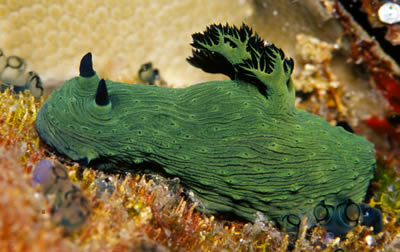
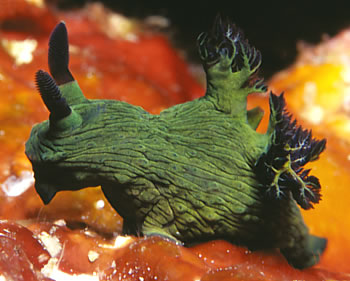
Hi Bill,
I think Nembrotha milleri and Nembrotha sp. 14 are the same animal. I have photographed about a dozen of these dark green slugs at the same divesite (Baby Cakes, aka Velvia) in the Solomon Islands in the past three years. My photos already on the Forum are from November, 1999. I photographed more of them in Nov. 2000 and Nov. 2001. Most of these Nembrotha are so dark that I have to overexpose the picture to see any detail. By last year I had learned to look for the lighter colored specimens. The attached images are from Nov. 2001. Bruce Potter's picture from last November also seems to be a lighter colored slug.
When I spread all my slides out on the light table I can see tubercles with dark centers on most of the specimens. However, it is difficult to see the tubercles in the darker specimens and they seem to flatten out when the animals are crawling. I should also point out that I have changed film. The images from 1999 were shot on Fuji Velvia and the current ones are on Kodak VS 100 film. I have not looked at the radula either, but suspect that the slug Bernard photographed in Tanzania is N. milleri. That would be quite a range extension!
Best regards,
Mary Jane
divepng@yahoo.com
Adams, M J., 2002 (Jul 14) Nembrotha milleri & Nembrotha sp 14. [Message in] Sea Slug Forum. Australian Museum, Sydney. Available from http://www.seaslugforum.net/find/6973Thanks Mary Jane,
I think the black centres in the pustules are in fact pores through which nasty chemicals are exuded on to the skin. Other species with longitudinal ridges and grooves seem to have similar pores hidden all along the grooves. I tend to agree that the Tanzanian animal is probably the same species, but the pustules tend to be uniformly black, rather than green with a black centre. I have moved Bernard's message on to the Nembrotha milleri page not because I am particularly in favour of 'lumping' them together, but because I suspect it will get forgotten if it is left alone on a Nembrotha sp. 14 Page. Cheers,
Bill Rudman
Nembrotha milleri feeding
June 12, 2002
From: Erwin Köhler
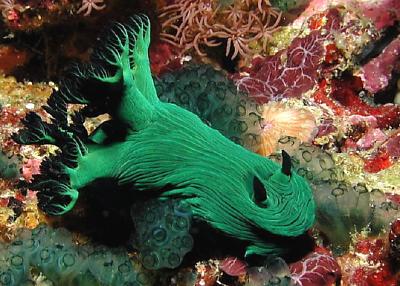
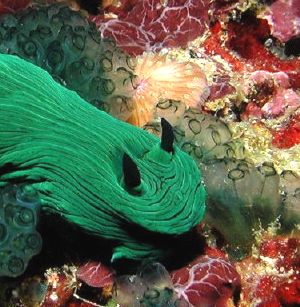
Dear Bill,
In seperate messages I sent Nembrotha kubaryana and Nembrotha cristata from the same dive at the Philippines, Balicasag Island. Here is Nembrotha milleri feeding on some ascidians.
Data:
size 74mm
depth 19 m
03 March 2002
Erwin
Erwin@medslugs.de
Köhler, E., 2002 (Jun 12) Nembrotha milleri feeding. [Message in] Sea Slug Forum. Australian Museum, Sydney. Available from http://www.seaslugforum.net/find/7193Thanks Erwin,
Bill Rudman
Nembrotha milleri from Western Australia
May 14, 2002
From: Richard Hall
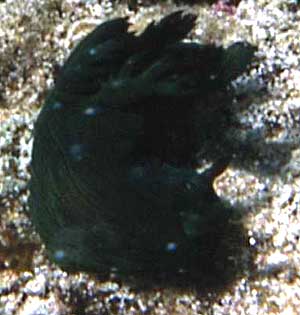
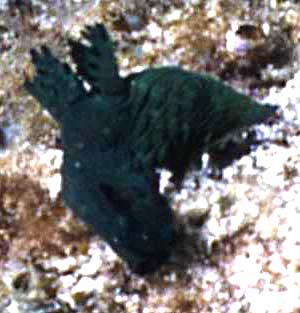
I have just recived my slides back from a recent trip to Dirk Hartog Island, Shark Bay Western Australia.
I took these photos of a nudibranch I saw on a limestone wall at about 6m. The only ID I have been able to draw out is that of Nembrotha cristata. However this is much further south than it has been reported so far.
Could you provide an ID as to what it is please.
Richard Hall
sharkbaydiver@yahoo.com.au
Hall, R., 2002 (May 14) Nembrotha milleri from Western Australia. [Message in] Sea Slug Forum. Australian Museum, Sydney. Available from http://www.seaslugforum.net/find/5881Dear Richard,
This is Nembrotha milleri. As you will see from the other messages on this page it is known from the tropical western Pacific so a record from western Australia is defintiely inetersting
Best wishes,
Bill Rudman
Nembrotha milleri feeding
May 13, 2002
From: Bernard Picton
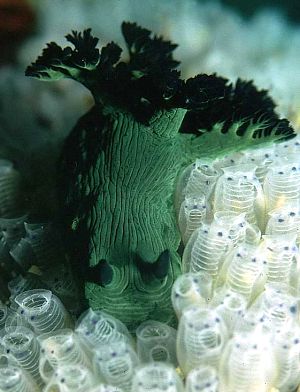
Hi Bill,
Here is a picture of Nembrotha milleri feeding on ascidians. I think this is a different ascidian (probably the same genus) to the one in Mary Jane's photo. It has a series of spots instead of rings.
PHOTO: Apo Island, Philippines - 2 April 1983 - BEPPH141
Bernard
bernard.picton.um@nics.gov.uk
Picton, B. , 2002 (May 13) Nembrotha milleri feeding. [Message in] Sea Slug Forum. Australian Museum, Sydney. Available from http://www.seaslugforum.net/find/6437Thanks Bernard,
Bill Rudman
Nembrotha from East Africa
May 13, 2002
From: Bernard Picton
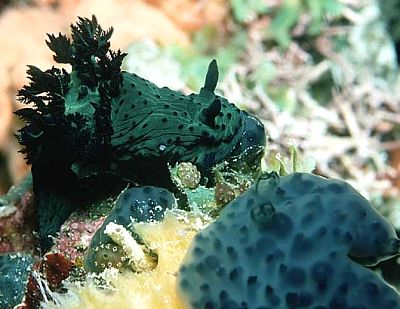
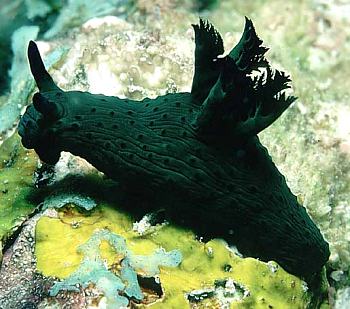
Note added 13 July 2002: This is probably N. milleri. See Mary Jane Adam's message.
Hi Bill,
Here are some photos of a dark green Nembrotha from Pemba Island, Tanzania, which is similar in colour to Nembrotha milleri. It has rounded tuberculate spots and is more slender than Nembrotha milleri. It was feeding on a colonial ascidian (family Polyclinidae?), shown in the picture. Debelius also has a picture of this species, page 184 as Tambja sp.. I haven't looked at the radula but guess it is a Nembrotha as it was eating ascidians.
PHOTOS: Feb 1999 - SW Pemba Is., Tanzania.
Bernard
bernard.picton.um@nics.gov.uk
Picton, B., 2002 (May 13) Nembrotha from East Africa. [Message in] Sea Slug Forum. Australian Museum, Sydney. Available from http://www.seaslugforum.net/find/6438Dear Bernard,
I found this animal in Tanzania also. I am pretty sure it the animal Eliot (1904) identified as Nembrotha cristata but that species is black with bright green spots, while this is green with small black spots. As far as I know it is unnamed. Your photo with it alongside the colonial ascidian suggest it is another animal with quite good colour camouflage.
Best wishes,
Bill Rudman
Nembrotha milleri? from Malaysia
December 15, 2001
From: Paul Jambunathan
Dear Bill
Hello from Malaysia. I belong to a group of very ardent divers who have a passion for the micro world. I need help identifying a nudi I spotted just two days ago. Dive site: Malaysia, Pulau Tioman.
We have, on many occasions spotted the Nembrotha kubaryana and Nembrotha cristata. There are variations in their coloration but they are clearly the ones. The new problem: The 'new' nudi was about 4 inches long( about 10cm). Body: dark green. Gills were black on the inside. Faint black lines running down from the head to about the gills. Antennae were clearly black only. In my books it looks very much like a Tambja. Thus the question on the differences. I would greatly appreciate it if you could also help me identify the one I saw. Very sorry about not being able to supply you with a photo. I haven't got to that stage yet.
Paul Jambunathan
pjambu@imu.edu.my
Jambunathan, P., 2001 (Dec 15) Nembrotha milleri? from Malaysia. [Message in] Sea Slug Forum. Australian Museum, Sydney. Available from http://www.seaslugforum.net/find/5806Dear Paul,
I think your animal is probably Nembrotha milleri. Have a look at Ian Potter's message from the Solomon Ids for a good photo. Interestingly, both Ian and Mary Jane Adams emtnion finding this species in association with Nembrotha kubaryana and Nembrotha cristata. May be it's because they are relatively common, or perhaps they all like the same food.
Concerning the difference between Tambja and Nembrotha. I am about to get an assistant to help clear the huge backlog of messages on the Forum. Once that is dealt with I am planning to include more anatomical information on these animals. There are no easy external features to separate species of Nembrotha from species of Tambja although there are plenty of internal differences especially in the structure of the gut, including the radular teeth. This reflects their quite different diet, species of Nembrotha feeding on ascidians [also known as tunicates or sea-squirts], while species of Tambja feed on arborescent bryozoans. [See Scott Johnson's message fro a nice photo of arborescent bryozoan].
Please let me know if my identification seems ok
Best wishes,
Bill Rudman
Nembrotha milleri from the Solomon Ids
December 3, 2001
From: Bruce Potter

Dear Bill,
Last Sunday (November 18), I dived a site called Velvia in the Florida group, Solomon Islands.
I found this Nembrotha milleri sitting at it's picnic, and thought it was worth sending you. It was about 55mm long, at about 12 meters. I also found Nembrotha kubaryana and Nembrotha cristata among other things.
Regards
Bruce Potter
bruce.potter@adventist.org.sb
Potter, B., 2001 (Dec 3) Nembrotha milleri from the Solomon Ids. [Message in] Sea Slug Forum. Australian Museum, Sydney. Available from http://www.seaslugforum.net/find/5708Dear Bruce,
Thanks for this beautiful photo. Interestingly, Mary Jane Adams in an earlier message, noted finding Nembrotha kubaryana and Nembrotha cristata together with N. milleri in the Solomon Ids.
best wishes,
Bill Rudman
Nembrotha milleri from Solomon Ids
April 7, 2001
From: Bruce Potter
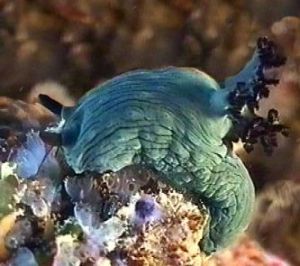
Bill,
I found this one on a dive site in the Florida group, Solomon Islands, called Velvia.
It was at about 12 meters.
Can you ID it for me?
Thanks
Bruce Potter.
bruce.potter@adventist.org.sb
Potter, B., 2001 (Apr 7) Nembrotha milleri from Solomon Ids. [Message in] Sea Slug Forum. Australian Museum, Sydney. Available from http://www.seaslugforum.net/find/4124Dear Bruce,
This is a nice photo of Nembrotha milleri feeding on a 'colony' or 'cluster' of ascidians [also known as tunicates or sea-squirts].
Best wishes,
Bill Rudman
Nembrotha milleri from Solomon Ids
August 2, 2000
From: Mary Jane Adams


Hi Bill,
Here is a slug to add to your Forum. Nembrotha milleri was described by Gosliner and Behrens in 1997 and named for branchophile Michael D. Miller. It was originally found in the Philippines and Sulawesi. I found several of them on a reef in the Florida Group of the Solomon Islands in November, 1999. They were about 45 mm long and were crawling on top of the reef at about 10 meters. This reef has lots of ascidians, which Behrens reports is their prey. I also found a large number of Nembrotha kubaryana and Nembrotha cristata at this divesite.
Regards,
Mary Jane
mjadams@earthlink.net
Adams, M.J., 2000 (Aug 2) Nembrotha milleri from Solomon Ids. [Message in] Sea Slug Forum. Australian Museum, Sydney. Available from http://www.seaslugforum.net/find/2799Thanks Mary Jane,
These dark green coloured species of Nembrotha are very difficult to photograph. The colour and 'velvet-like' nature of their skin seems to suck in all the light, leaving none for the photo. I have includede enlarged sections of the head and gills to give everyone an indication of the colour pattern.
I have also enlarged a little group of an ascidian with a deep green ring around the inhalent and exhalent siphons. There are a number of clumps of these in your upper photo it is actually pressing its head against such a clump. Gosliner & Behrens (1997) state that this species has not been found in association with a specific prey, but on your suggestion I have checked this with Dave Behrens who says:
"Yes, this is the species of tunicate we always find N. milleri feeding on in the Philippines. The type locality, Devil's Point, Batangas Region, Luzon, Philippines is covered with this colonial ascidian, which we have had identified as Sigillina signifera".
Best wishes,
Bill Rudman.
